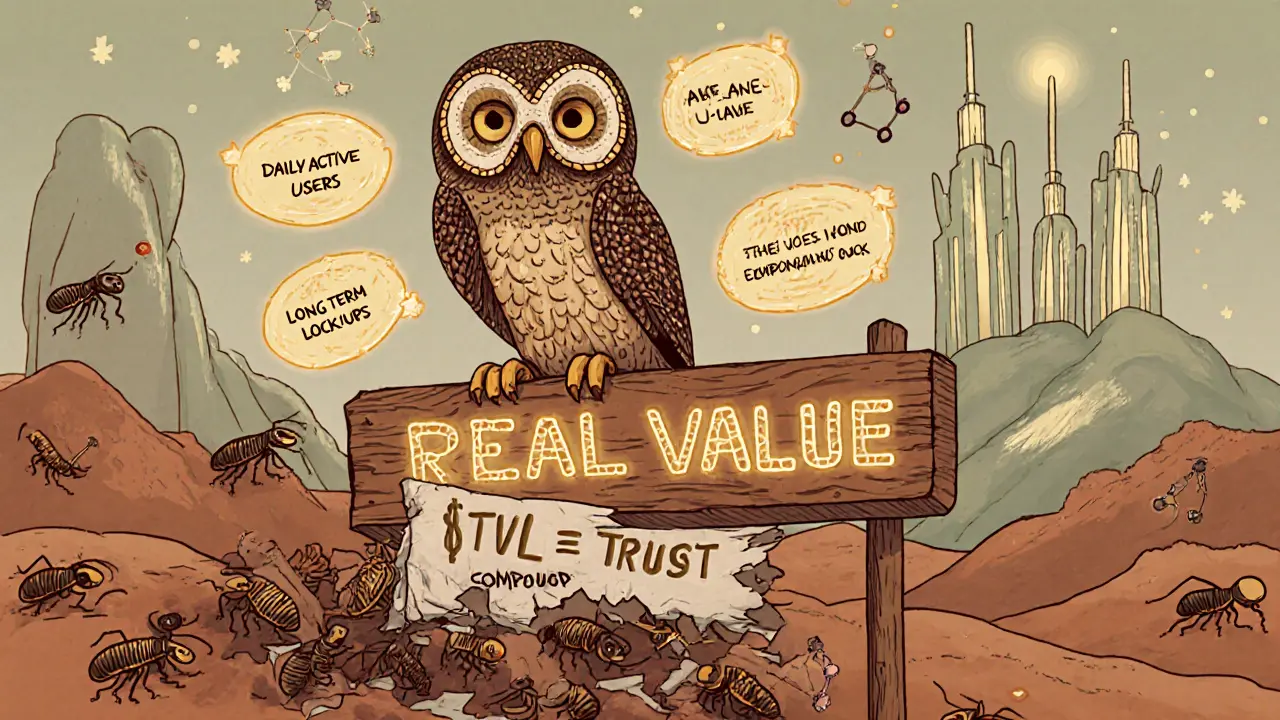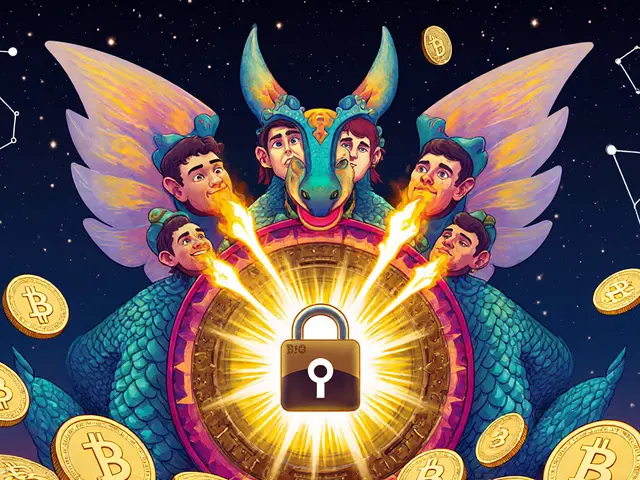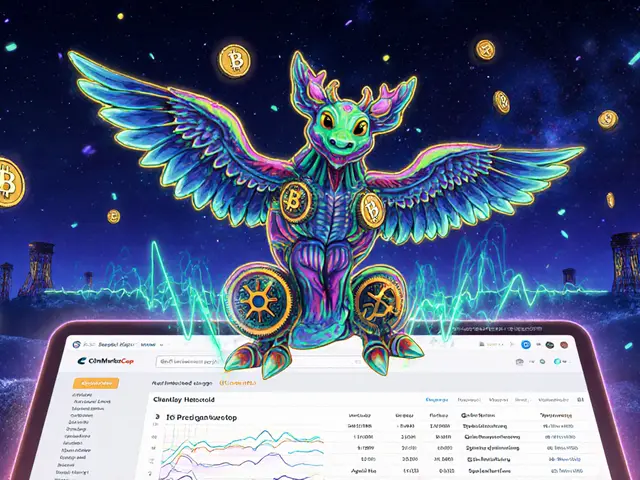TVL Quality Score Calculator
This tool helps you assess whether a DeFi protocol's Total Value Locked (TVL) is reliable or potentially manipulated. Based on industry best practices, it evaluates key metrics that indicate genuine protocol health.
TVL Quality Assessment
Your TVL has a 72/100 quality score.
This indicates moderate reliability. While some metrics are strong, there are areas of concern that could indicate potential manipulation.
- Token concentration is below the red flag threshold (20%)
- APY is within sustainable range (35%)
The lock-up period is short-term (less than 30 days), which often indicates speculative activity rather than genuine long-term commitment.
When you see a DeFi protocol boasting $5 billion in Total Value Locked (TVL), it sounds impressive. It suggests trust, popularity, and success. But what if that number is a mirage? What if the money isn’t really there-or worse, it’s been moved around like a shell game to make the numbers look bigger than they are? That’s TVL manipulation, and it’s happening more often than most people realize.
What TVL Really Measures (And What It Doesn’t)
Total Value Locked is supposed to tell you how much money users have deposited into a DeFi protocol-whether it’s for staking, lending, or providing liquidity. It’s calculated by adding up the current dollar value of all crypto assets locked in a protocol’s smart contracts. If 10,000 ETH is staked and ETH is trading at $3,000, that’s $30 million in TVL. Simple, right?
But here’s the catch: TVL doesn’t measure actual usage, revenue, or even safety. A protocol can have $1 billion in TVL and still be losing money every day. It can have millions in locked assets but only a few hundred active users. TVL tells you how much is locked up, not whether people are using the platform, whether the code is secure, or whether the rewards are sustainable.
And because investors, VCs, and new users rely on TVL to decide where to put their money, it’s become the most coveted metric in DeFi. That’s why people cheat.
How TVL Gets Manipulated
There are a few common tricks used to inflate TVL numbers. Most of them rely on exploiting how TVL is calculated-and how little scrutiny it gets.
- Self-dealing liquidity pools: A protocol creates a fake trading pair-say, its own token paired with USDC-and then dumps a ton of its own tokens into the pool. Since the TVL formula counts both sides of the pool, the protocol artificially inflates its number. The tokens aren’t locked by real users-they’re locked by the team itself. This is called "phantom liquidity."
- Price manipulation: If a token’s price is artificially pumped, its value in TVL goes up-even if no new money entered the system. Teams sometimes coordinate with market makers to briefly spike the price of their token, then report a "record TVL" right after. Once the pump ends, the TVL crashes, but the damage is done: headlines are written, new users are lured in, and the team moves on.
- Yield farming bait: Protocols offer insane APYs-like 500% or even 2,000%-to lure in users. These users deposit their assets, and TVL spikes. But the rewards are paid out in the protocol’s own token, which has no real value. Once the incentives stop, users pull their money out, and TVL collapses. The protocol doesn’t care-it already got its moment in the spotlight.
- Multi-chain hopping: A protocol launches on five different blockchains. It moves the same $10 million from Ethereum to Arbitrum to Polygon, and reports TVL on each chain separately. That makes it look like $50 million is locked across the ecosystem. In reality, it’s the same money, just being counted five times.
- Token swaps with insiders: A team swaps large amounts of their token with friends or shell wallets, then locks those tokens into the protocol. The TVL rises, but the tokens never left the team’s control. This is called "wash locking."
These aren’t theoretical risks. In 2024, a protocol called AlphaFinance claimed $800 million in TVL. Independent analysts later found that over 70% of that came from a single wallet that had deposited the protocol’s own token. When the team stopped paying rewards, the TVL dropped to $120 million in under two weeks. No one lost money on the smart contract-everyone lost money on the hype.
Why TVL Is Still Used (And Why It’s Dangerous)
Despite knowing the flaws, people still use TVL as a primary metric. Why?
Because it’s easy. It’s a single number. You can compare two protocols in seconds. You can make a chart. You can tweet about it. It’s the financial equivalent of judging a restaurant by how many people are sitting outside-even if they’re all there because the owner paid them to wait in line.
Platforms like DeFiLlama and DappRadar make it even worse. They display TVL as if it’s a trusted statistic, like GDP or stock prices. But they don’t filter out self-dealing, don’t track token volatility, and don’t warn you when a large portion of TVL comes from a single address. They’re just aggregators. They don’t verify. They don’t audit. They just count.
And that’s the problem. Investors who don’t dig deeper assume TVL = safety. They see a protocol with high TVL and think, "If so much money is here, it must be legit." But that’s exactly what scammers count on.

What to Look at Instead of TVL
If you’re not supposed to trust TVL, what should you trust?
- Real user activity: Look at daily active addresses. If TVL is $1 billion but only 500 people interact with the protocol each day, something’s off. Real protocols have thousands of daily users.
- Revenue and fees: Does the protocol actually make money? Check its on-chain revenue. If it’s paying out more in rewards than it collects in fees, it’s burning through cash. That’s not sustainable.
- Token distribution: Who holds the majority of the protocol’s token? If more than 20% is held by a single wallet, that’s a red flag. If the team controls over 30%, they can manipulate the price-and TVL-anytime they want.
- Protocol ownership: Is the contract upgradeable? Can the team pause withdrawals or change the rules? If yes, it’s not decentralized. And if it’s not decentralized, TVL means nothing.
- Lock-up periods: Are users locking their assets for months? Or are they depositing for a 7-day yield farm and pulling out immediately? Long-term locks mean real commitment. Short-term deposits mean speculation.
There’s a reason the most trusted DeFi protocols-like Aave, Compound, and Uniswap-don’t brag about their TVL. They focus on usage, security, and revenue. Their numbers grow slowly, steadily, and because people actually use them-not because they paid influencers to post about them.
The Bigger Picture: Why This Matters
TVL manipulation isn’t just about fake numbers. It’s about trust erosion.
Every time a protocol inflates its TVL and then collapses, it damages the reputation of the whole DeFi space. New users get burned. Regulators take notice. Exchanges delist tokens. Investors pull back.
And the worst part? The people who get hurt aren’t the whales or the insiders. They’re the everyday users who saw a big number, trusted it, and lost money because they didn’t know how to look deeper.
DeFi was supposed to be transparent. But if the most important metric is being faked, then transparency is an illusion.

What’s Being Done About It?
Some projects are trying to fix this. l2Beat now flags protocols with suspiciously high TVL from single addresses. DeFiSaver adds a "TVL Quality Score" that adjusts for token volatility and concentration risk. A few analytics firms are now tracking "real locked value"-the amount of assets locked by non-team wallets over 30+ days.
But these are still niche tools. Most users still look at the top TVL chart on DeFiLlama and assume it’s accurate.
The real solution? Education. If users stop treating TVL like a scorecard and start asking harder questions, the incentives to cheat will disappear. No one wants to run a fake business if no one believes the numbers anymore.
Is TVL a reliable indicator of a DeFi protocol’s success?
No, TVL is not a reliable indicator of success. It only shows how much money is locked in a protocol, not whether users are actively using it, whether the protocol is profitable, or whether the assets are genuinely locked by real users. Many protocols inflate TVL through self-dealing, price manipulation, or fake yield farms. A high TVL can even signal risk if it’s driven by unsustainable incentives.
Can TVL go up even if no new money is deposited?
Yes. TVL is calculated by multiplying the amount of assets locked by their current market price. If the price of a token increases-due to market hype, pump-and-dump schemes, or coordinated buying-the TVL rises even if no new deposits were made. This is why TVL can spike during bull runs and crash during downturns, regardless of actual user behavior.
How do I tell if a protocol’s TVL is manipulated?
Look at three things: (1) How many unique addresses are depositing? If one or two wallets hold most of the TVL, it’s likely manipulated. (2) Is the token price volatile or recently pumped? (3) Are the rewards unusually high (e.g., over 100% APY)? Also check if the protocol lists its top depositors-many fake protocols hide this data. Tools like l2Beat and DeFiSaver now flag suspicious TVL patterns.
Why do protocols bother manipulating TVL?
Because TVL drives funding and attention. VCs use TVL to decide which projects to invest in. Exchanges use it to list tokens. Influencers promote projects with high numbers. A protocol with $1 billion in TVL gets media coverage, even if it’s just a shell. Once they get attention, they can sell tokens, attract users, and exit before the collapse.
Are there any DeFi protocols with truly clean TVL?
Yes. Established protocols like Aave, Compound, and Uniswap have high TVL that’s mostly driven by real, long-term deposits from diverse users. Their TVL grows slowly, correlates with actual usage, and isn’t tied to short-term yield incentives. They also publish transparent data on token distribution and revenue. These are the exceptions-not the rule.
Final Thought: Don’t Chase Numbers. Chase Truth.
TVL is a mirror. It reflects what you want to see-not what’s really there. If you’re investing in DeFi, don’t fall for the shiny number. Dig deeper. Ask who’s locking the money. Ask how long it’s been locked. Ask if the protocol makes money or just burns it. Ask if the team can change the rules.
Real value isn’t measured in dollars locked. It’s measured in trust, usage, and sustainability. And those things? They can’t be faked.











14 Comments
TVL is just a vanity metric. I’ve seen protocols with $2B in TVL that had 300 daily users and a team wallet holding 80% of the supply. It’s not finance, it’s theater.
Exactly. You need to look at daily active addresses and fee revenue. TVL without usage is like counting the number of cars in a parking lot and assuming the restaurant inside is busy. Most of these protocols are just pump-and-dump farms with fancy UIs.
THIS. I lost my entire life savings on a protocol that had ‘$1.4B TVL’ on DeFiLlama. Turned out the whole thing was one guy swapping his own tokens between wallets and calling it ‘liquidity’. I cried for three days. Now I check token distribution before I even click ‘approve’.
they’re all fake the government and the banks are in on it they’re using this to track us and when you lock your crypto they tag your wallet and then the feds freeze everything next thing you know you’re on a no fly list and your dog gets taken away
so we’re supposed to believe that the guy who wrote this actually reads the whitepaper before investing? lol. i bet he’s got 17 tokens in his wallet that he bought at the peak and now he’s just mad because he didn’t rug pull fast enough.
TVL is the modern equivalent of judging a person by their suit. It’s surface level. It’s easy to measure. It makes people feel smart for noticing it. But real value? That’s in the silence between the numbers. In the code that doesn’t change. In the users who stay even when the yield dies.
STOP CHASING NUMBERS AND START CHASING TRUST!! If you’re not looking at who’s holding the tokens or how long they’ve been locked you’re not investing you’re gambling and that’s fine but don’t cry when you lose
big thanks for this post man. i was just about to put my eth into some new farm with 1200% apy. now i’m gonna check l2beat first. you saved me from losing my rent money lol
While I appreciate the technical breakdown, I must emphasize that the broader issue lies in systemic over-reliance on quantifiable metrics without qualitative context. The financial markets have long suffered from this syndrome. DeFi is merely replicating the same errors at exponential speed.
if you’re new to defi and you read this and you’re scared? good. that means you’re learning. don’t put money in anything you don’t understand. take your time. ask questions. read the docs. even if you miss out on a 10x, you’ll still have your money. that’s a win.
oh wow a blog post that tells you not to trust the charts. groundbreaking. next you’ll tell me the sun rises in the east and water is wet. how original. i’m sure the author’s own token has a clean TVL and zero team holdings.
TVL is not just manipulated-it’s weaponized. The entire DeFi ecosystem is a performance art piece designed to make the gullible feel like they’re part of the revolution while the architects quietly cash out. I don’t invest in protocols. I invest in people who admit they don’t know what they’re doing.
the real issue isn’t the manipulation-it’s that people still treat this like it’s banking. crypto isn’t about safety. it’s about risk. if you want safety, go to a bank. if you want to gamble, at least know the odds. this post helps with that.
you know what’s funny? people get mad when TVL is faked but they don’t even realize that the whole concept of locking value in smart contracts is kinda absurd when you think about it like really if you think about it in terms of metaphysics and existential economics then isn’t all value just a shared hallucination anyway? like if everyone believes in the price of eth then it has value but if one person stops believing then it’s just data on a blockchain and we’re all just ghosts in a machine trying to convince each other that the numbers matter when really they’re just reflections of our collective fear and desire for meaning in a chaotic universe